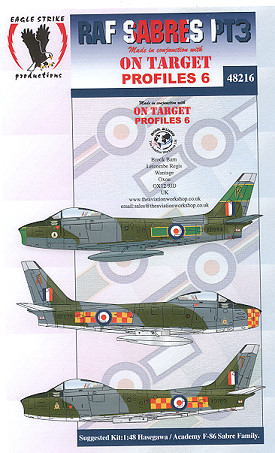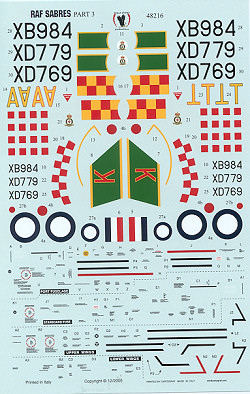 I am one of
thousands of modelers who think that the coolest early 50's jet fighter is the
F-86. When I was a small child my father would take me to the end of the runway
at Wheelis AFB every weekend and we'd watch planes take off and land. Most of
those planes in 1952/53 were F-86s and it was then that I was hooked.
I am one of
thousands of modelers who think that the coolest early 50's jet fighter is the
F-86. When I was a small child my father would take me to the end of the runway
at Wheelis AFB every weekend and we'd watch planes take off and land. Most of
those planes in 1952/53 were F-86s and it was then that I was hooked.
This particular sheet is done in co-operation with The
Aviation Workshop in the UK as part of their 'On Target' book series. For kits,
either the Hasegawa or Academy F-86 is recommended and both of them are good
ones. Now, it is time to get to the differences. All British Sabre F.4s were
built by Canadair and so are basically F-86Es. This means they have short,
slatted wings as produced. Some were later retrofitted with the unslatted 6-3
wing with fences, but since these are all from the 1954/55 time f rame
I doubt if any were so fitted. This means one has to be very careful in choosing
the right kit in order to get these slatted wings. Right now, I can't think of
which one would be the most appropriate, so perhaps a reader can help out here.
rame
I doubt if any were so fitted. This means one has to be very careful in choosing
the right kit in order to get these slatted wings. Right now, I can't think of
which one would be the most appropriate, so perhaps a reader can help out here.
All these Sabres had the upper surfaces in Dark Green/Dark
Sea Grey with a black nose anti-glare panel.
First up is a 3 Squadron plane from 1954. This aircraft has a
PRU Blue underside and drop tanks. A late note on this plane. Larry Milberry's
book 'The Canadair Sabre' has a description of the markings of this exact
aircraft in which he states that the fin band and letter were outlined in the
flight's color of white, not yellow as shown on the sheet (page 261).
Next is the Squadron Leader's plane from 92 Squadron. This
and the following plane have silver lacquer undersides and drop tanks. AMD has
provided both separate checks and formed ones for the nose.
The last option is a standard 92 Squadron plane for those who
may be a bit squeamish about trying the nose markings! You'll also find the
individual aircraft letter provided in both red and black outline as it was
impossible to tell from photos which was used. Late note on this one as well.
Milberry's book as mentioned above states that black was the color used for the
individual aircraft letter outline (pg 280).
There are enough insignia and data markings to do one
aircraft and the instructions provide a data placement guide.
February 2006
Review sheet courtesy of
 I am one of
thousands of modelers who think that the coolest early 50's jet fighter is the
F-86. When I was a small child my father would take me to the end of the runway
at Wheelis AFB every weekend and we'd watch planes take off and land. Most of
those planes in 1952/53 were F-86s and it was then that I was hooked.
I am one of
thousands of modelers who think that the coolest early 50's jet fighter is the
F-86. When I was a small child my father would take me to the end of the runway
at Wheelis AFB every weekend and we'd watch planes take off and land. Most of
those planes in 1952/53 were F-86s and it was then that I was hooked.  rame
I doubt if any were so fitted. This means one has to be very careful in choosing
the right kit in order to get these slatted wings. Right now, I can't think of
which one would be the most appropriate, so perhaps a reader can help out here.
rame
I doubt if any were so fitted. This means one has to be very careful in choosing
the right kit in order to get these slatted wings. Right now, I can't think of
which one would be the most appropriate, so perhaps a reader can help out here.
